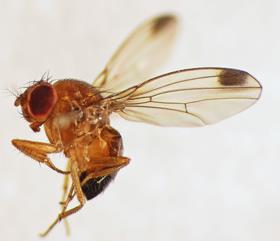
Understanding a fruit fly’s internal body clock may hold the key to fighting off a soft fruit pest that continues to devastate crops worldwide.
The new technique to control Spotted Wing Drosophila (SWD), which could involve the use of spray baits at strategic times, has the potential to control the fruit flies more effectively than conventional spraying techniques.
PhD student Bethan Shaw, who is carrying out the research with funding from the AHDB and the University of Southampton, is working to predict what time of day the pest lays its eggs on crops, including berries, grapes and stonefruit, so she can advise growers to spray at these times.
“Spotted Wing Drosophila has become a problem because the females have a highly serrated ovary depositor which they use to cut into the skin of under-ripe and ripening soft fruit,” Shaw explained in a presentation at the Great British Tomato Conference in Kenilworth on 29 September.
Unlike other Drosophila species, SWD does not target decomposing fruit and once the female has laid its eggs, the larvae consume the still-ripening fruit from within, causing it to collapse.
The pest outbreak has caused considerable economic losses in both the US and Europe, since it arrived on the continent in 2008. And it was first discovered in the UK in 2012.
But Shaw is hopeful that if she can understand the fly’s circadian clock, which coordinates an organism’s behaviour in line with environmental changes, she could provide vital information to growers.
“People notice the side effects of their circadian clock being disrupted in things like jet lag,” she explained. “The aim of my project is to try to understand at what time of day this fruit fly is performing key behavioural outputs such as egg-laying as this is when the fruit is vulnerable.
“We’re also looking at peak in movement so that we can say to growers: ‘At this time of the day, in these conditions, you will find more flies in your crop so you may have a better trap catch.’”
The researcher is also optimistic that her work could bring environmental benefits by reducing the frequency with which soft and stone fruit growers treat their crops.



